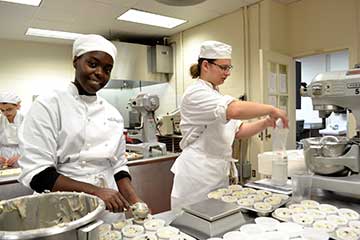Fundamentals of Baking and Confections Microcredential
What is a Microcredential?
Check out Chef Hatalsky and some of our baking students talking about the program on Spectrum News!
Whether you are looking to upgrade skills in your current profession or enter a new field, a microcredential may be for you. Microcredentials are short, industry-focused credentials designed to provide in-demand skills that reflect the “shop floor” needs of industry. They are accelerated or “bite sized” training opportunities focused on a specific professional or career discipline and can lead to a certificate or to an initial or advanced degree.
 The purpose of this microcredential is to introduce prospective students to the fundamentals
of baking, including cake and cookie decorating, bean-to-bar chocolate making, and
the production of bon bons and other candy and confections while preparing them for
employment in a bakery, or candy/confection shop. In addition to the serious student,
this micro-credential should appeal to the home baker as a path to improve and learn
new skills and as a transition to employment.
The purpose of this microcredential is to introduce prospective students to the fundamentals
of baking, including cake and cookie decorating, bean-to-bar chocolate making, and
the production of bon bons and other candy and confections while preparing them for
employment in a bakery, or candy/confection shop. In addition to the serious student,
this micro-credential should appeal to the home baker as a path to improve and learn
new skills and as a transition to employment.
Upon completion of this microcredential, students will be able to:
- Identify and apply the basic techniques of bean-to-bar chocolate production and the production of bon bons and other confections.
- Identify and apply the fundamentals of baking science to the preparation of a variety of products.
- Properly use and care for equipment normally found in a chocolate kitchen, bakeshop, or baking area.
Fundamentals of Baking and Confections Microcredential Courses
Part-time TAP for Non-Degree Credentials Eligibility
The Fundamentals of Baking and Confections microcredential is eligible for the New York State Part-Time Tuition Assistance Program (TAP) for Non-Degree Credentials program. Provided that you meet the income eligibility requirements, this program may be able to contribute toward the cost of tuition. Income eligibility is as follows:
- $125,000 for dependent undergraduate students, independent students who are married and have tax dependents, or independent students who are unmarried and have tax dependents
- $60,000 for married independent undergraduate students who have no other dependents
- $30,000 for unmarried independent undergraduate students with no dependents
If you believe you earn less than the amount listed in the criteria above, you should apply by completing the FAFSA and TAP applications. Please note you have a lifetime of eight semesters of TAP. These will be prorated for the number of credits you earn, but will use a portion of your lifetime TAP eligibility. Please contact the Office of Financial Aid at 518-381-1468 or email to financialaid@sunysccc.edu with any questions.